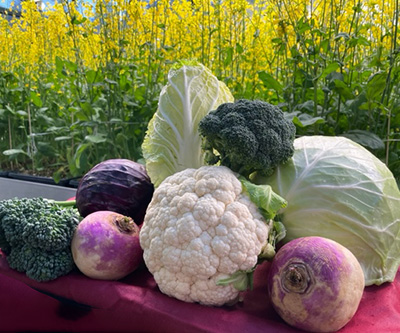Blog Post Sections
- Announcing Brassicas Around the World Lesson
- Hands-On Fast Plants Experiment Models Brassica Selection Around the World
- This Investigation is Ideal for…
- Connecting Science and Culture
- Relevance of Fast Plants and Brassicas Around the World
Announcing Brassicas Around the World Lesson
The Wisconsin Fast Plants team is proud to announce a revision and content overhaul to one of our legacy resources: Around the World with Brassicas. This new revision is a significant expansion into a classroom lesson/investigation, while maintaining content from the legacy resource. It presents an overview of Brassica species, providing examples of the diversity within this plant genus and describing the economic importance of several Brassica varieties. The investigation begins with a phenomenon that is observable in most every produce aisle: Many of the vegetables that botanists classify as Brassica look and taste very different.
All of the materials/resources generated for this lesson are provided free to use, as Open Source learning materials. You can access all of the Investigating Brassicas Around the World resources here. This blog post provides an overview of the lesson and background information to support educators using this lesson in their classroom.
Alternative/mirror link: https://drive.google.com/file/d/1GNJjKHDLeIKNRppLSS0gzE6auarNIm5v
Hands-On Fast Plants Experiment Models Brassica Selection Around the World
This investigation begins by engaging students through their prior knowledge of Brassica vegetables and cuisines. Students are supported to grow their own population of Brassicas, using Wisconsin Fast Plants (Brassica rapa) as a model organism. Students engage firsthand with Brassica growth, development, and reproduction through an artificial selection experiment. Growing their own plants allows observation of variation in live plants. This provides a crucial piece of evidence and understanding that will help students explain this investigation’s phenomenon.

The investigation then provides resources and materials for students to gather evidence and explore the investigation’s overarching question: How is it that so many plants classified as Brassica look and taste different? After students have collected sufficient information, then they are challenged to develop and discuss a claim about the origins of Brassica, supported by reasoning and the evidence they gathered.
This Investigation is Ideal for…
This investigation is ideal for middle school science or high school agricultural science. The investigation takes about a week of time when students are working each day to gather evidence. Then, students can work on your usual lessons for another 4-5 weeks, while their Fast Plants are growing. It will take only a few days additional time to pollinate, harvest, and germinate seeds that students produce.
While the term/grouping of vegetables as “Brassicas” likely is a new concept for students, the investigation’s materials support students to be curious and build their understandings, using multiple learning modalities. Students are supported through this investigation to learn about:
- the life cycle of flowering plants,
- how environmental and genetic factors influence growth of organisms (using Fast Plants as a model organism),
- how humans influence the inheritance of organisms, such as through plant breeding,
- how scientists use classification as a tool for understanding relatedness among organisms, and
- how structures differ in form and function in plants and in other organisms.

Throughout the investigation, students actively engage in developing an evidence-based explanation to the question, How is it that so many plants classified as Brassica look and taste so different? Initially, students plant Brassica seeds (Fast Plants) to observe firsthand their life cycle. Later, they selectively intermate their plants as a model for plant breeding. This firsthand experience with plants and plant breeding levels the field of prior knowledge for all students to learn about Brassicas. Simultaneously, students explore what is a “Brassica” by observing a selection of Brassica vegetables from the grocery store. In addition, they research the breeding of diverse Brassicas around the world. Finally, they explore scientific classification, using age-appropriate resources provided in this lesson. These resources include videos, interviews, readings, protocols, and presentations.
Connecting Science and Culture
This investigation is full of opportunities to connect science and culture. We include suggestions for utilizing culturally responsive strategies while students learn the roles Brassica vegetables play and have played in cultures around the world. Further, this investigation includes insights into how the scientific community’s understanding of Brassica origins is growing and changing because of insights provided by ethnobotanists and others who recognized the importance of contributions from people and cultures often overlooked by traditional researchers. The work conducted by Alex McAlvay, a botanist at the New York Botanical Gardens, and his co-researchers highlights this example. Their research combined genetic, environmental, linguistic, and literary evidence to clarify the domestication history of Brassica species. Click the following links to read recently published scientific articles about the origins of Brassica rapa and Brassica oleracea.
Relevance of Fast Plants and Brassicas Around the World
Wisconsin Fast Plants serve as a relevant model organism in this investigation because they, too, are classified in the genus Brassica. The Brassica genus belongs to a large family of plants known as crucifers (Latin = Cruciferae). Crucifers name refers to the characteristic shape of their flowers, specifically, four petals in the shape of a cross or crucifix.
Brassicas have great economic and commercial value and play a major role in feeding the world’s populations. Therefore, they are an appropriate vegetable and plant group for students to learn about. They range from nutritious vegetables, mustards and oil producing crops, to animal fodders and weeds. Brassicas are also important for modern research. Scientists are currently exploring Brassicas for their potential to provide food security in conditions brought about by climate change.
Excited yet? We are too! You can access all of the Investigating Brassicas Around the World resources here (links to a Google Drive folder).


